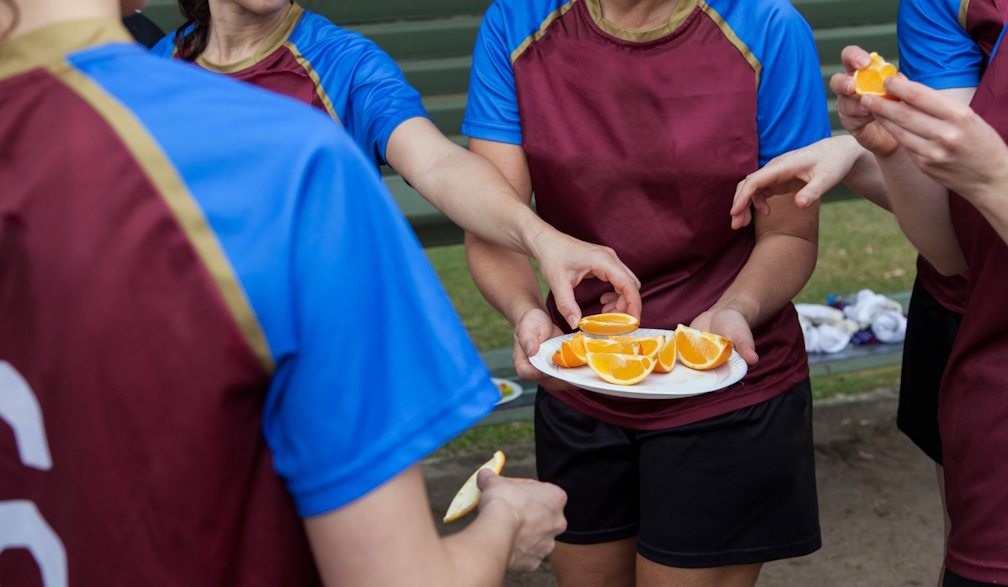How and why did half-time oranges in junior sports become a tradition?
- Written by Vaughan Cruickshank, Senior Lecturer in Health and Physical Education, University of Tasmania

Eating oranges at half-time has been a popular[1] and long-standing tradition at junior sports in countries such as Australia, the United Kingdom and the United States.
They are also regularly eaten by professional athletes in competitions such as the Australian Football League[2], as well as the National Basketball Association[3] and National Football League[4] (NFL) in America.
In fact, the NFL’s game operations manual[5] states each home team must provide “three dozen sliced oranges for half-time” for the visiting team, as well as other things like ice, coffee and gum.
But why do we do this? And how did it start?
Origins of oranges in sport
The exact origins of this relationship between oranges and sport are hard to pin down.
According to US business Florida Fruit Shippers, eating oranges has been a tradition in England since the 1950s[6].
Another suggested origin story, from the America Youth Soccer Organisation[7], is the tradition was started by a donation from a supportive local citrus growing business.
It has also been suggested that in Australia and the UK, it may have emerged during the second world war, linked to government concerns about poor nutrition[8] after rationing.
Similar to school students being given free[9] milk[10] to help prevent diseases such as rickets[11], they were also given oranges to assist with vitamin c and iron deficiencies[12], as vitamin c has been[13] shown[14] to enhance iron absorption[15] from plant sources.
Benefits of eating oranges
Fruits like oranges contain carbohydrates, vitamins and minerals; carbohydrates are important in providing energy while vitamins and minerals are important in growth and development.
Together these nutrients help contribute to good health[16].
In Australia, only about two-thirds of children up to the age of 18 eat the recommended serves of fruit[17]. For good health, you should try to eat at least two serves of fruit every day[18].
Encouraging children to eat fruit could help improve their health and sports performance.
To help children perform in junior sports it is important to provide healthy snacks[19] that help them to play at their best.
Choosing fruit at half-time (or quarter-time) is a great way to increase fruit intake. There are also benefits from eating oranges over lollies, which contain only added sugars.
One benefit is oranges (along with watermelon, strawberries or grapes) is that they contain large amounts of water[20]. This can help with staying hydrated, which is vital in all sports at all ages.
Another benefit is oranges contain natural sugars to provide energy during exercise. This makes them ideal half-time snacks.
An average sized orange will provide around 10-12 grams[21] of carbohydrate via natural sugars. This carbohydrate is easy to digest to provide sustained energy.
In sports with shorter durations, additional bursts of energy[22] are not always essential, as muscle stores are less likely to be as depleted.
So although oranges aren’t essential in shorter duration sports that go for less than 75 minutes, they can assist with hydration, provide a release of energy and include key nutrients[23] to help children stay healthy.
Plus, their natural sweetness can make them enjoyable.
Are there any downsides?
Despite the benefits of eating oranges, 15 years ago, Netball Queensland[24] reportedly banned them at half-time.
The concern? Potential damage to children’s teeth due to the acidity of oranges. Coaches were encouraged to promote fluids instead of oranges to keep players hydrated.
While it’s true that increased consumption of fruits[25] and fruit juices can harm teeth, eating a few orange slices at half-time is unlikely to cause significant damage[26].
In fact, dehydration[27] is more of a concern for dentists due to the resulting lack of saliva production.
Saliva helps to protect the teeth from tooth decay and erosion – when saliva production is reduced, so too is the protection of teeth.
Recently, some South Australian soccer clubs have also banned oranges[28], with some teams replacing them with lollies. This shift seems to have evolved from parents talking to each other and deciding a sugar hit is beneficial.
But lollies are often sticky, causing them to adhere to the tooth’s surface and remain there for extended periods. This prolonged exposure to sugar increases the risk of tooth decay.
A fact sheet endorsed by Nutrition Australia and Australian Dental Association states eating lollies is not recommended[29] for junior players.
Not everyone has given up on the orange though.
The Victorian government’s Vic Kids Eat Well program still promotes the idea of “refuel with fruit[30]”, encouraging junior players to snack on easy-to-prepare fruits such as sliced oranges and apples.
They also suggest lower-acidity alternatives like watermelon or bananas.
So while it’s difficult to know exactly how, where and why oranges became so ubiquitous in sport, they do seem to serve a purpose for athletes of all ages and abilities.
References
- ^ popular (www.clearinghouseforsport.gov.au)
- ^ Australian Football League (www.smh.com.au)
- ^ National Basketball Association (studentedge.org)
- ^ National Football League (www.nytimes.com)
- ^ operations manual (www.nytimes.com)
- ^ 1950s (blog.orangesonline.com)
- ^ America Youth Soccer Organisation (www.facebook.com)
- ^ poor nutrition (pubmed.ncbi.nlm.nih.gov)
- ^ free (www.schoolhousemuseum.org.au)
- ^ milk (education.qld.gov.au)
- ^ rickets (www.rch.org.au)
- ^ iron deficiencies (www.jstor.org)
- ^ been (www.sciencedirect.com)
- ^ shown (pubmed.ncbi.nlm.nih.gov)
- ^ iron absorption (www.betterhealth.vic.gov.au)
- ^ health (www.eatforhealth.gov.au)
- ^ fruit (www.aihw.gov.au)
- ^ day (www.eatforhealth.gov.au)
- ^ healthy snacks (www.vickidseatwell.health.vic.gov.au)
- ^ water (www.canr.msu.edu)
- ^ 10-12 grams (fdc.nal.usda.gov)
- ^ energy (www.sportsdietitians.com.au)
- ^ nutrients (glycemic-index.net)
- ^ Netball Queensland (www.medindia.net)
- ^ fruits (rjor.ro)
- ^ significant damage (www.sportsdietitians.com.au)
- ^ dehydration (academic.oup.com)
- ^ banned oranges (7news.com.au)
- ^ not recommended (www.sportsdietitians.com.au)
- ^ refuel with fruit (www.vickidseatwell.health.vic.gov.au)




















